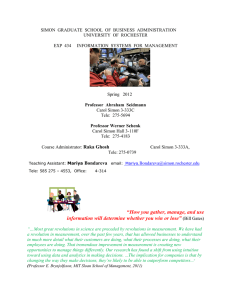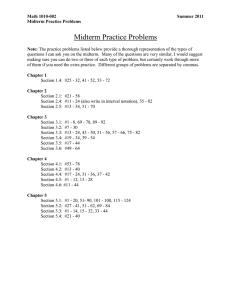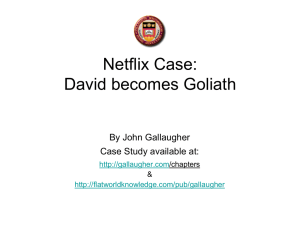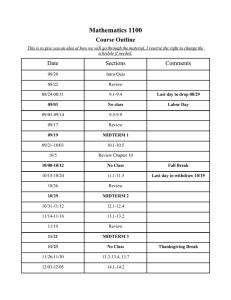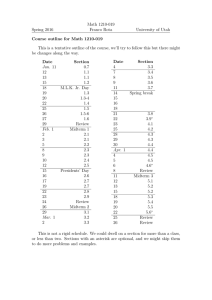SIM MON GRADU UATE SCH OOL OF BU
advertisement
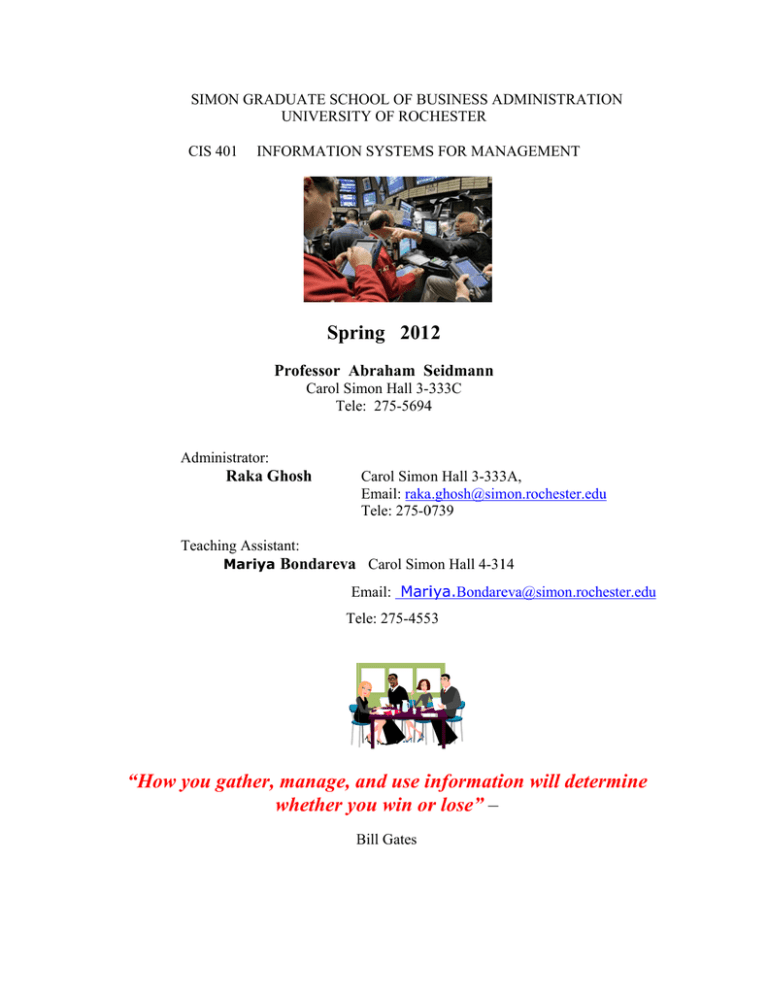
SIM
MON GRADU
UATE SCHOOL OF BU
USINESS A
ADMINISTR
RATION
UNIVERSIT
U
TY OF ROCH
HESTER
CIS 401
INFO
ORMATION
N SYSTEMS
S FOR MAN
NAGEMENT
T
Spring 2012
Prrofessor Abraham
A
S
Seidmann
Carol Sim
mon Hall 3-3333C
Telee: 275-56944
Admin
nistrator:
Raka Gh
hosh
Carol Simonn Hall 3-3333A,
Email: rakaa.ghosh@sim
mon.rochesteer.edu
Tele: 275-00739
hing Assistan
nt:
Teach
Mariya Bondareva
B
Carol Simoon Hall 4-3114
Email:
E
Mariiya.Bondareeva@simon..rochester.eddu
Teele: 275-4553
“H
How you gather,
g
manage,
m
and
a use in
informatiion will ddeterminee
whether
w
yo
ou win orr lose” –
Bill
B Gates
“…Most great revolutions in science are preceded by revolutions in measurement. We
have had a revolution in measurement, over the past few years, that has allowed
businesses to understand in much more detail what their customers are doing, what their
processes are doing, what their employees are doing. That tremendous improvement in
measurement is creating new opportunities to manage things differently. Our research
has found a shift from using intuition toward using data and analytics in making
decisions. ...The implication for companies is that by changing the way they make
decisions, they’re likely to be able to outperform competitors….”
(Professor E. Brynjolfsson, MIT Sloan School of Management, 2011)
To use Information Technology competitively, your organization must embed IT within its
structure, culture, and business strategy. INFORMATION SYSTEMS FOR MANAGEMENT
teaches you how to seize the vast opportunity presented when you do IT right.
Remember, those who know only HOW, work for those who know WHY. Therefore
strategically understanding the why, is our main focus here.
Tech skills are being “built into” jobs everywhere.
There isn’t a single modern managerial discipline that isn’t being deeply and
profoundly impacted by tech.
Most of the jobs you are likely to land on did not exist twenty years ago…..
Our plan is to look beyond the information-age hype served up by today’s pundits and
prognosticators, and to offer instead durable management principles that have proven their
effectiveness through decades of practice. The course is designed to provide an eminently useful
guide that facilitates a deeper understanding of the fundamental forces at work in today’s—and
tomorrow’s information economy.
We plan to begin with a general overview of today's information economy, identifying some of
the forces that are changing the many organizational structures. The course will then explore six
major themes:
The value of information
Managing corporate data resources
2
Developing effective information systems
The emerging business impact of social networks
The role of information technologies in business process innovations
Developing network externalities as a source of unique competitive advantage
Key Executive Takeaways:
Lessons in how to best use your information resources
Strategies to improve customer intimacy using Mobile Technologies and the Internet
Frameworks for improving the fit between IT investments and your business strategy
Business models for strategic use of Big Data, Analytics Computing and e-commerce:
what works, what doesn’t
This core class examines how modern information systems serve as the key driver for solving
major business problems and how they facilitate business innovations by rapidly transforming
firms’ organizational architectures, business boundaries, markets, products, and processes. The
class explores some of the ways that computer mediation already affects economic transactions.
These computer-mediated transactions have enabled significant improvements in the way
transactions are carried out and will continue to impact the economy for the foreseeable future.
For instance, it is hardly novel to suggest that contractual form depends on what is observable.
What is interesting for the students is the way that progress in information technology enables
new contractual forms.
Specific topics include the economics of information and IT, the
structure of electronic businesses, developing information systems and managing information
resources, the key elements required for effective data mining and business intelligence, and how
organizations should use their information technology as they translate their overall business
strategy into a series of actual profit-producing activities.
3
Our cutting-edge course mixes current industry insights, theoretical approaches, and hands-on
experience to give you an appreciation for the management issues surrounding the development
and use of information technology (IT) in organizations. Its focus is on the broader managerial
and organizational issues raised by new information technologies such as the Web 2.0,
Relational Databases, ERP, RFID, or CRM and their role in shaping the business world of the
future.
The lab is designed to provide an extensive exposure to personal computing. This lab has two
major objectives. The first is to illustrate and reinforce the various concepts taught in the
lectures. The second major objective is to provide advanced working knowledge of Access
databases and expose students to innovative business modeling capabilities.
The class builds rapidly upon what you have learned in previous lectures, the labs and concurrent
core courses. You must, therefore, constantly keep pace. You may find that much of the action
in the lab has to do with the mechanics of the formulation and solution of information system
problems. That is not the purpose of the course, but we believe that it is the best way of
accomplishing our educational goals. The simple exercises are complemented by more
comprehensive assignments that capture more realistically the complexity of managerial
problems. The homework problems you will do are intended to give you practices in developing
decision support models and in developing effective information systems. The feedback from
these exercises should help you evaluate your progress and understanding. Much of the material
builds on topics covered in previous weeks. To keep abreast, it is important that you try to solve
these problems (mostly alone) on a regular basis.
The most meaningful way to differentiate your company from your competitor, the best way
to put distance between you and the crowd, is to do an outstanding job with information...
4
5
6
Text:
Text: Required
R
In
nformation Systems: A Manager'ss Guide to H
Harnessing T
Technologyy (1.3)
By
B John Gallaugher
Pub Date: Deecember 2011
Edition:
E
1.3,
IS
SBN (Color)):978-1-4533
3-2293-2
URL
U
http://sttudents.flatw
worldknowled
dge.com/couurse/871259
mended:
Recomm
(I)
New
N Perspecctives on Miicrosoft Offfice Excel 20010, Introdu
uctory Editiion
Authors:
A
Parssons, Oja, Ag
geloff, Carey
y
IS
SBN-13: 978
8-0-53-8742
239-9
(II)
New
N Perspecctives on Miicrosoft Offfice Access 22010, Introd
ductory Ediition
Authors:
A
Adaamski, Finneegan
IS
SBN-13: 978
8-0-53-8798
848-8
7
For update : I suggest you look at:
For update : I suggest you look at:
The blog (Week in Geek) can be found at
http://gallaugher.com
Prof’ Gallaugher twitter account can be followed at:
http://twitter.com/gallaugher
HARVARD PUBLICATIONS and CASE PACKAGE
REQUIRED
[Using unauthorized photocopies of Harvard Business School cases
constitutes a violation of U.S. copyright laws.]
1.
Harrah's Entertainment, Inc.
Jun 14, 2004
2.
Case 9-502 – 011
Google Inc.
April 11, 2011
3.
Case 9-910-036
Wikis at Dresdner Kleinwort Wasserstein: (A), (B), (C)
Aug 30, 2006
4.
Case 9-606-074,-075,076
Facebook October 28, 2011
5.
Case 9-808-128
Keda's SAP Implementation Jan 20, 2011
6.
Case W11024
TopCoder (A): Developing Software Through Crowdsourcing January 15, 2010
Case 9-610-032
8
7.
Best Buy's CEO on Learning to Love Social Media Dec 1, 2010
8.
HBR R1012A
Building Watson: It's not so elementary my dear! September 6, 2011
9.
Case 9-612-017
Visioning Information Technology at Cirque du Soleil September 2011
10.
HEC027
Mustang Music (A) Published : 2010
Case 910E09
Threadless: The Business of Community 11.
June 30, 2008
Product (DVD): 608707-MMC-ENG 9
General Expectations from Each Student:
Treat class sessions like business meetings. Unprofessional behavior has
a negative impact on the participation grade. Specifically:
I.
Attend each class. Send me a courtesy email if you cannot make it to class.
II.
Attend the section you are enrolled for. Unless instructed otherwise by
me, my signup sheet and my TA will not record your attendance or
participation if you are in the wrong section. If you have a reason to attend
the other section sometime, let me get you permission. If you have a
permanent reason to be in the other section, you should switch officially
through the Simon Registrar’s office.
III.
Be on time. Late arrivals are disruptive both for instructors and students.
The same applies to leaving the room temporarily during class.
IV.
No Eating in class.
V.
Have your PRINTED name card up in every class. Use the printed one,
not a hand-written one. You CAN NOT attend class without those.
VI.
No laptops/ (smart) phones, iPads, etc’. Please silence your phones and
put them away. There is also no class-relevant use for a laptop; leave it off
and take notes by hand. One Exception is the ‘Business Games’ where you
have to use your laptop.
GRADES:
23% Midterm, 28% Team Assignments* and Individual class participation,
Wiki (Individual) 7%, Team Project 7%, 35% Final.
(*We drop the Team Hwk assignment with lowest group assignment score).
Attendance is normally required at all your assigned Lectures & Labs, sessions and
for the full duration of the session.
* The midterm and final exam are closed books. No makeup exams will be given. It is your
responsibility to be at the exams on time. Please make arrangements with me ASAP if you must
miss an exam.
10
Both the midterm and the final exam will test you on lecture as well as lab material. We reserve
the right to increase a selected number of final grades when the student's final exam shows a
significant improvement over their midterm exam. I also solicit written feedback on teammembers' participation in the preparation of homework and the course project. This information
may be used in determining your individual contribution and your score. (Please see the attached
last page).
On Class Participation:
The global competitive situation is such that managers today cannot
hire a team of assistants to help them with their analytical work. They must become more
effective and efficient by learning how to use computers to leverage what they know so that their
specific knowledge can be applied many times and in many places. In addition, general
managers spend a lot of time communicating with others. For this reason, I have given a high
priority in the class to the development of interpersonal communication skills. The strength of
this class will be in direct relationship to the contribution of its members. This sharing of
expertise and inquiry is particularly true for core MBA classes where your experiences are so rich
and diverse. Please come to class well-prepared to enter the discussion — to ask questions and
provide information that will further you, your colleagues', and my understanding of the topic.
Do not limit your role to that of student but expand it to include teacher, trainer, guide and
friend. You should think of the classroom as a laboratory in which you can test your ability to
convince your peers of the correctness of your approach to complex problems and of your ability
to achieve the desired results through the use of that approach. Make sure you always have with
you at least one printed name sign.
Since every faculty member differs slightly in his or her expectations of students, I will outline a
few of my criteria for effective class participation:
1.
Is the participant a good listener?
2.
Are points made relevant to the discussion and linked to the comments of others?
3.
Do the comments show evidence of independent analysis of the issue? i.e., are
comments more than a "rehash" of the stated facts?
4.
Is there a willingness to participate?
5.
Is there a willingness to test new innovative ideas, or are all comments "safe"?
11
6.
Do comments clarify and highlight the important aspects of earlier comments and
lead to a clearer statement of the concepts and managerial action plans being
covered?
NOTE: Most homework assignments will require the use of a personal computer. Homework
assignments may be done in teams, or individually, as directed.
Recommended Web materials:
Although this is not a technical class and no technology background is needed, you may once a
while encounter some technical terms in your readings or in class discussions. You can find the
definitions of such technical terms (and others you may encounter outside this class) on the
internet. In particular, three good sources of technical information are:
http://www.webopedia.com/
http://www.wikipedia.org/
http://www.techweb.com/encyclopedia
We strongly encourage you to use this valuable resource to clarify unanswered questions and to
go beyond the material covered in class, according to your own personal interests.
DATES AND TIMES
LECTURE
LAB
Room S107
(Sec 31): MONDAY, WEDNESDAY
1:30-2:50
(Sec 32): MONDAY, WEDNESDAY
3:10-4:30
(Sec 31/ 37): THURSDAY
11:20-12:40
(Sec 32/38): THURSDAY
01:30-02:50
12
Organization
Technology
Process
INFORMATION SYSTEMS FOR MANAGEMENT
Professor Abraham Seidmann
Lectures
1. M, March 26
Topics
I. Introduction
The economic impact of Information Technology
Information as a good
2. W, March 28
I. Introduction
The economic impact of Information Technology
Network Effect:
3. M, Apr2
I. Introduction
The economic impact of Information Technology
Pricing Information
13
4. W, April 4
II. Information and Data Base Management
The Harrah’s Entertainment Inc Case
[http://www.harrahs.com]
5. M, April 9
II. Information and Data Base Management
Organizing Business Data: EVPI
6. W, April 11
II. Information and Data Base Management
Database and query Design:
Business Applications
Mitigating the impact of Information Asymmetry
7. M, April16
II. Information and Data Base Management
Using Capacity Data and Pricing Information for Supply Chain
Competition:
The iCAPS Game {Please bring your laptop}
8. W, April 18
III. Emerging Information Technology Systems
The “Google” Case
[http://www.Google.com]
9. M, April 23
III. Emerging Information Technology Systems
The “WIKIS AT DRESDNER” Case
[http://www.dresdnerkleinwort.com/eng/ ]
An Executive Perspective on:
Wikis, Blogs, Buzz, Webkinz, Second Life….
10. W, April 25
IV. Project Management
Managing large-scale business projects
Building and analyzing network models
11. M, Apr 30
All cohorts: @ 1:00pm- 2:30pm
Midterm Exam: Details to follow
(Everything covered in lectures through Monday, April 23, inclusive and
in lab last week, inclusive.)
12. W, May 02
IV. Project Management
Project Management Trade-offs
Incorporating the role of cash-flows, bonus, penalty, and
acceleration cost
13. M, May 7
IV. Project Management
Sensitivity and Risk Analysis
14
14. W, May 9 V. Redesigning the Modern Organization with Information Systems
The “Keda’s SAP Implementaion ” Case
[http://www.kedachina.com.cn/English/AboutKD/]
[http://www.SAP.com]
15. M, May 14
V. Redesigning the Modern Organization with Information Systems
Managing the Development Project: SDLC Model
16. W, May16
V. Redesigning the Modern Organization with Information Systems
The "Facebook " Case
[http://www.Facebook.com]
17. M, May 21
VI. Strategic Information Systems
The Role of Information and Technology in the Financial Markets
The TradewindBusiness Game {Please bring your laptop}
18. W, May 23
VI. Strategic Information Systems
The “Threadless: The Business of Community”
[http://www.threadless.com]
19. W, May 30
VI. Overview and System Selection
Using the MCDM Methodology
15
SIMON GRADUATE SCHOOL OF BUSINESS ADMINISTRATION
UNIVERSITY OF ROCHESTER
TEAM GRADING POLICY
Since part of your final grade will include work done in study teams, it is important to establish a
grading format for the teams. Unless I hear from you, I will assume that each member of the
team did his or her fair share, and points will be distributed equally among each team member.
If this assumption is incorrect, please follow the procedure below and return this form to me
prior to the final examination.
To allocate different points to members of your study team, take the number of members in your
group (including yourself) and multiply by two (2). This will give you the number of points to
be allocated to your team. In the space below, allocate the number of points you want to assign
to your teammates. You must provide an explanation if you are assigning points unequally.
Study Team
___
Points
Your name:
Other members:
Total Points (equal to 2 times the number of members):
Explanation:
Signatures: ___________________________________________________________________
16
